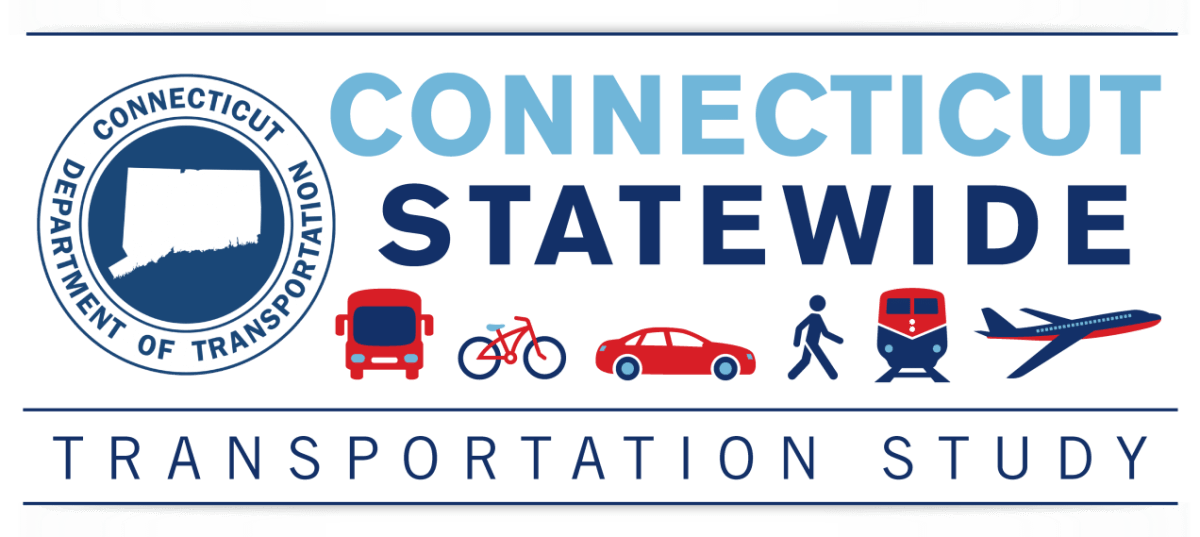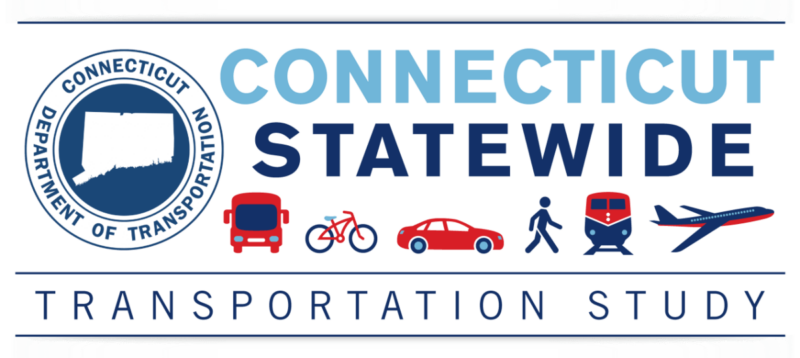The Naugatuck Valley Council of Governments is requesting proposals from qualified firms of certified public accountants to conduct an examination and to render an opinion on the comprehensive annual financial statements of the Naugatuck Valley Council of Governments. Proposals will be received at our offices until 3:00 p.m. on April 29, 2016 at which time no further proposals will be considered. Request for Proposal forms may be obtained at the office of the Finance Director from 8:30 a.m. until 4:30 p.m. on Mondays through Fridays. Information concerning this Request for Proposal may be obtained by contacting Clare Falcha, Finance Director at (203) 757-0535. The Naugatuck Valley Council of Governments is an Equal Opportunity Employer.
Connecticut Statewide Transportation Study is Collecting information

The Connecticut Statewide Transportation Study is collecting information about everyday transportation choices and travel patterns in the state of Connecticut. The study reaches out to Connecticut residents to understand their travel behaviors including how they travel, where they go, why they travel, and how long it takes. This information is vital for transportation agencies in the state including the Connecticut Department of Transportation to not only understand how the existing transportation system serves the residents of the state but also to plan for future transportation needs.
The data collected in this study will be used primarily to develop and update a statewide transportation model that will allow CTDOT to study how the transportation system is impacted by growth, development and other changes in communities and regions across the state. The results from the model will allow planners and policymakers to make informed choices about which transportation infrastructure (including roadways, bridges, rail systems, bus routes, pedestrian and bicycle facilities) to maintain and develop. Reliable and viable travel options enhance the quality of life of residents and promote economic vitality of businesses, and this study will help transportation agencies in the state of Connecticut meet this objectives.
For more information about this study, please visit the following websites:
- https://cttransportationstudy.org
- http://www.cti.uconn.edu/connecticut-statewide-transportation-study
RFP: Revolving Loan Fund Cleanup Funds
Please submit all materials digitally to Arthur Bogen at abogen@nvcogct.org and to Max Tanguay-Colucci at mcolucci@nvcogct.org by 4:30pm on Tuesday, March 15, 2016. More details can be found in the attached package, which includes the RFP, relevant Q&A, and the pre-app. Note that NVCOG can make grants to municipalities or qualifying not-for-profits, or loans to private developers (working directly with municipalities) through the Revolving Loan Fund.
Public Informational Meeting March 2, 2016 State Project No. 36-195 – Everyone Welcome
Everyone is invited to a public information meeting on Wednesday, March 2, 2016. Snow Date is Wednesday, March 9, 2016. The presentation will be at 7:00 p.m. and a Question and Answer period will immediately follow. Derby City Hall, Aldermanic Chambers, 1 Elizabeth Street, Derby Connecticut
Residents, commuters, business owners, and other interested individuals are encouraged to take advantage of this opportunity to discuss the proposed improvements.
Written questions or comments should be directed to: Mr William W. Britnell, P.E., Connecticut Department of Transportation, Principal Engineer of Highway Design, P.O. Box 317546, Newington, Connecticut 06131-7546 or at e-mail address William.Britnell@ct.gov
NVCOG seeks contractor to perform regional election monitoring
REQUEST FOR CONTRACTOR
REGIONAL ELECTION MONITOR
The Naugatuck Valley Council of Governments (NVCOG), based in Waterbury, CT, seeks a consultant to perform regional election monitoring under the supervision of the NVCOG Director of Municipal Services and at the direction of the Connecticut Secretary of the State. This is a contractual position to be funded by the Connecticut Secretary of the State through NVCOG. The contractor will also work with registrars and other town officials from the 19 NVCOG member municipalities.
Compensation will be per diem or hourly by negotiation. Click here for more details
Each applicant interested in providing these services shall submit their resume, and a cover letter outlining their relevant experience. Consulting or law firms are also invited to respond with the same information. The proposal should be sent to the Municipal Shared Services Coordinator, NVCOG, 49 Leavenworth Street, Waterbury, CT 06702 no later than 2:00 pm on Thursday, February 25, 2016. Electronic submissions are acceptable to jobs@nvcogct.org. An interview with a committee organized by the NVCOG Municipal Shared Services Coordinator may be required. NVCOG is an Equal Opportunity Employer. EOE/M/H/F
Click here for full Job description
Click here to view MOU between the Office of the Secretary of the State and NVCOG
Don’t Miss the January 28th Corridor Conference
January 28th Conference to Detail Infrastructure, Development Strategies for Greater Naugatuck Valley Region’s Economic Development
The Naugatuck Valley Council of Governments (NVCOG) will host “NVision 2020, the Naugatuck Valley Corridor Conference on Infrastructure and Development” on Thursday, January 28, 2016 at the Palace Theater, 100 East Main Street, Waterbury, from 10 a.m. to 2 p.m.
“With continued public investment in the transportation and technology substructure of the Naugatuck Valley Corridor, we can build a significant, lower-cost economic asset for the entire state,” said NVCOG Executive Director Rick Dunne. “This conference will bring key stakeholders together to discuss and plan for the region’s future and capitalizing on our existing, mature infrastructure should play a major role in this regard.”
Confirmed speakers include Connecticut Comptroller Kevin Lembo, Department of Transportation Commissioner James Redeker, Tim Sullivan, Deputy Commissioner of the Department of Community and Economic Development, Joseph McGee of the Business Council of Fairfield County, Naugatuck Mayor N. Warren “Pete” Hess, Laura Brown, Community and Economic Development Educator, UConn Extension, David Fink, Policy Director, Partnership for Strong Communities and David Carol, Project Manager, JV Team, NEC FUTURE.
The program will detail a number of crucial topics including: Urban Development trends and drivers of business relocation, The importance of Connectivity: Connecting all major regions of Connecticut via the NV Corridor, Developing regional gigabit fiber technology, Establishing new transit connections and services. Other issues will include Reclaiming downtown and riverfront brownfields to open them to development; Restoring the ability to access the significant infrastructure obstructed by antiquated, inaccessible & underutilized industrial sites, and Stimulating greater private investment by creating the conditions for sustainable, transit-dependent communities in our downtowns.
In addition to speaking presentations, there will be a panel discussion on Developing Sustainable Communities, which will discuss evolving community trends and issues, framing the new economy, housing factors and transit-oriented-development. The Linking the Region panel discussion will discuss partnerships between regions and transportation issues in the region and will address the potential for adding a northern route to the Northeast Corridor Rail System that will bring a high-Speed Rail Hub to Waterbury, directly connecting the region with the DC to Boston Corridor.
There is no charge to attend the conference, which is open to the public. Registration information can be found at nvcogct.org .
American Red Cross Winter Storm Safety Tips
RFP for Administration and Operation of a Household Hazardous Waste Drop-Off Program
RFP: Revolving Loan Fund Cleanup Funds
The Naugatuck Valley Council of Governments (NVCOG) manages an EPA funded Brownfield Revolving Loan Fund (RLF). The NVCOG announces this Request for Proposals for subgrants of cleanup funds to eligible municipal members of the Regional Brownfield Partnership of West Central Connecticut (RBP).
NEC Future Hearings Summary
NEC FUTURE
December 2015
NEC Future is a Federal Railroad Administration-led effort to envision the future of the Northeast Corridor. The effort has identified several opportunities and investment alternatives for rail service in the State of Connecticut. The vision is unconstrained by funding limits, constructability, environmental or community impacts. The FRA is seeking public comments on the NEC Future Draft Environmental Impact Statement (DEIS). FRA has scheduled public forums in New Haven on December 14 and Hartford on January 13. They will also accept written comments through January 30, 2016.
Connecticut Department of Transportation (CTDOT) is looking forward to hearing your comments on the NEC Future DEIS. CTDOT will provide comments once other Connecticut stakeholders have had an opportunity to review the document and participate in the public forums. Following are some key points and potential questions for your consideration during the public hearing and comment period.
NEC Future Alternatives
No Action Alternative includes a $9 Billion infrastructure base cost.
- The No Action Alternative continues current funding levels which are inadequate to meet the growing backlog in basic state of good repair of the railroad. It does not allow for increased peak-hour rail service, though some modest increases in off-peak service may be possible.
Maintain – Alternative 1 $52 to $54 Billion plus $9 Billion infrastructure base cost.
- Alternative 1 maintains the mode share of rail as it is today, keeping pace with the level of rail service required to support projected growth in population and employment.
- Alternative 1 includes new rail services and commensurate investment in the NEC to expand capacity, add tracks, and relieve key chokepoints, particularly through northern New Jersey, New York, and Connecticut. This alternative is similar to the Let’s Go CT vision for intercity trains and high frequency trains, though there is much more work to do to identify specific service plans and investment needs.
Grow – Alternative 2 $116 to $121 Billion plus $9 Billion infrastructure base cost.
- Alternative 2 grows the role of rail, expanding rail service and passenger use at a faster pace than the growth in regional population and employment.
- The existing NEC generally expands to four tracks, with six tracks through portions of New Jersey and southwestern Connecticut. South of New Haven, CT, service and infrastructure improvements are focused generally within the existing NEC.
- North of New Haven, Alternative 2 adds a new supplemental, two-track route between New Haven and Hartford, CT, and Providence, RI, to increase resiliency, serve new markets, reduce trip times, and address capacity constraints.
- It is not clear how this alternative treats the New Haven-Hartford-Springfield program vision of inland route service to Boston and service to Montreal.
Transform – Alternative 3 $258 to $293 Billion plus $9 Billion infrastructure base cost.
- Alternative 3 transforms the role of rail, positioning it as a dominant mode for intercity travelers and commuters across the NEC.
- Service and infrastructure improvements include upgrades on the existing NEC and the addition of a two-track second spine within the Study Area.
- This new spine supports high-performance rail services between major markets and provides additional capacity for anticipated growth.
Qs & As for CT
How do the alternatives address current travel demand as well as projected future travel demand?
Alternative 1 maintains current market share, requiring new investment to keep pace with population growth and employment. Alternative 2 accommodates projected 2040 demand. Alternative 3 allows for expanded growth beyond the project 2040 demand. These alternatives make assumptions about future economic growth and development in the corridor and customer preferences which are linked to service levels and pricing. It appears the biggest return on investment (defined solely on ridership and market share) is with Alternative 1 with lesser benefits accruing from Alternative 2 and Alternative 3. The economic impacts and future land use impacts are not part of this evaluation.
What are the potential implications and impacts of the different alternatives?
The NEC Future document offers three distinct alternatives and No Action baseline for comparison purposes. The purpose of the NEC Future planning effort is to identify a vision for future investment in the Northeast Corridor. All three alternatives would require extraordinary investment, many orders of magnitude greater than current funding levels. These alternatives must not only be evaluated from an economic perspective, but also viewed through the lens of community and environmental benefits and impacts.
What is the role of the Federal government (i.e., FRA, Amtrak) in advancing the NEC Future Program?
The Federal Railroad Administration has indicated the selection of a preferred alternative will be informed by the public comments it receives during this comment period. Critical issues for CT include federal funding commitments for the existing system and any of the alternatives in addition to the need to have EIS documentation for critical infrastructure investments in CT.
How do the alternatives impact service and capacity on the New Haven Line?
The advancement of one or more of the three alternatives would require discussion with FRA and Amtrak on the future of the Northeast Corridor/New Haven Line and branch lines. Specific service plans are not available at this time. FRA plans to complete a Service Development Plan after a final alternative is selected.
Other questions that may be considered during the public comment period:
What is actually sought by FRA in terms of public input?
This is an enormous amount of information to read, understand and comment on. Is it possible to extend the comment period?
While the overall costs have been estimated, there is no funding plan. When will that be done?


